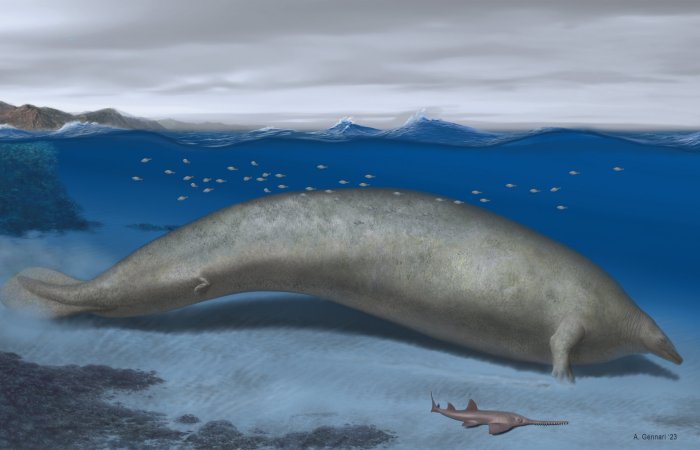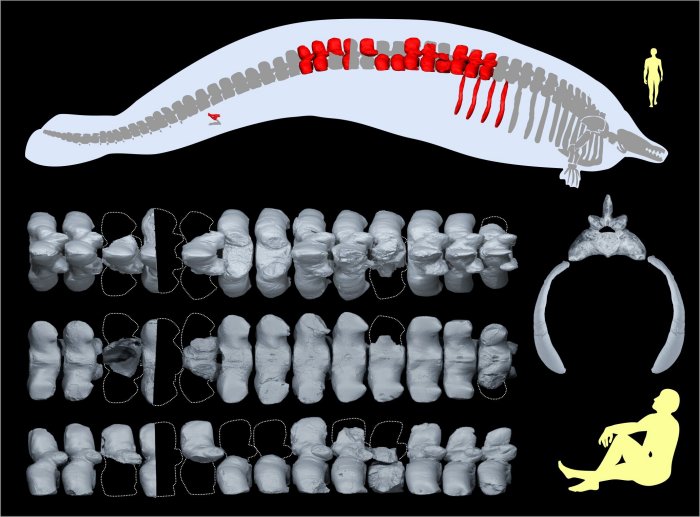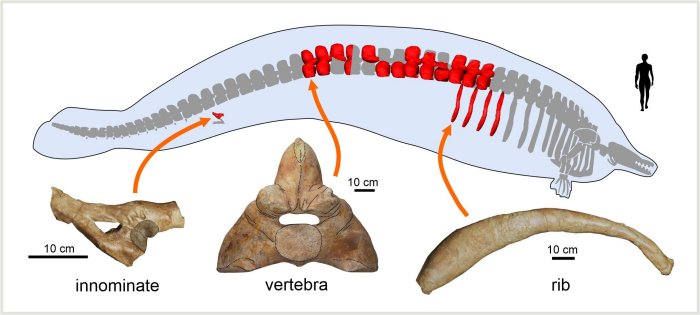Jan Bartek – AncientPages.com – Scientists have discovered a partial skeleton of a whale that lived about 40 million years ago. Researchers say it is possible this is the heaviest animal ever to have lived.
Until now, Balaenoptera musculus, the blue whale, has been regarded as the largest species on Earth, including all dinosaurs. Nicknamed giants of the sea, blue whales can reach a length of 29.9 meters (98 ft) and weigh up to 199 tonnes (196 long tons; 219 short tons).

Reconstruction of Perucetus colossus in its coastal habitat. Estimated body length: ~20 meters. Credit: Alberto Gennari
The discovery of Perucetus colossus, a basilosaurid whale from the middle Eocene epoch of Peru, may force the world of science to reconsider what animal was largest and heaviest.
According to a study published in Nature, the prehistoric giant whale from Peru had an average body mᴀss of 180 metric tons.
The Basilosaurid whale substantially pushes the upper limit of skeletal mᴀss in mammals, as well as in aquatic vertebrates in general. This early whale combines a gigantic size and, to our knowledge, the strongest degree of BMI known to date. It also potentially represents the heaviest animal ever described,” scientists write in their study.
According to Guinness World Records, the world’s heaviest blue whale was a female weighing 190 tonnes (418,878 lb) and measuring 27.6 m (90 ft 6 in) in length. Now, scientists estimate the ancient whale’s weight range was between 85 and 340 tons, meaning it could have been significantly larger than the heaviest blue whale ever discovered.
The first fossil of the ancient whale was discovered back in 2010 by Mario Urbina, a paleontologist who has spent decades searching the desert on the southern coast of Peru.

Preserved bones of the new species, Perucetus colossus. Credit: Giovanni Bianucci
“There is no record of the existence of an animal as large as this, it is the first, that’s why nobody believed me when we discovered it,” Urbina told AFP in Lima.
According to the researcher, this discovery “is going to cause more questions than answers and give the rest of the paleontologists a lot to talk about.”
During a press conference at the Natural History Museum in the Peruvian capital, the remains of the whale were displayed to the public for the first time. Scientists informed a total of 13 gigantic vertebrae—one of which weighed nearly 200 kilograms (440 pounds) were found at the site, as well as four ribs and a hip bone.
It took many years to collect and prepare the fossils. After long studies, scientists could finally reveal the animal is a new species of basilosaurid, an extinct family of cetaceans.
Modern cetaceans include dolphins, whales, and porpoises, but their early ancestors lived on land, some resembling small deer.
Over time they moved into the water, and basilosaurids are believed to be the first cetaceans to have a fully aquatic lifestyle. One of their adaptations at that time was gigantism, and they became very big.
But the new discovery indicates that cetaceans reached their peak body mᴀss roughly 30 million years earlier than previously thought, the study said.
The researchers estimate that the whale that roamed the ocean 40 million years ago reached about 20 meters (65 feet) in length.
As reported by the ᴀssociated Press, “like other basilosaurids, Perucetus colossus likely had a “ridiculously small” head compared to its body, Amson said—though there were no available bones to confirm this.
The researchers were confident that the animal lived in shallow waters in coastal environments, due to the strange heaviness of its bones.
Its whole skeleton was estimated to weigh between five and seven tons—more than twice as heavy as the skeleton of a blue whale.
“This is—for sure—the heaviest skeleton of any mammal known to date,” as well as any aquatic animal, Amson said.
Perucetus colossus needed heavy bones to compensate for the huge amount of buoyant blubber—and air in its lungs—which could otherwise send it bobbing to the surface.
But just the right balance of bone density and blubber allowed the giant animal to stay in the middle of around 10 meters (33 feet) of water “without moving a muscle,” Amson explained.
Felix Marx, a marine mammal expert at the Museum of New Zealand Te Papa Tongarewa not involved in the study, told AFP that Perucetus colossus “is very different from anything else we’ve ever found.”

Preserved bones of the new species, Perucetus colossus. Credit: Giovanni Bianucci
“The main feature of this animal is certainly the extreme weight, which suggests that evolution can generate organisms that have characteristics that go beyond our imagination,” University of Pisa paleontologist Giovanni Bianucci said.
Perucetus colossus appears to have been a peaceful animal and moved slowly due to its size.
“Because of its heavy skeleton and, most likely, its very voluminous body, this animal was certainly a slow swimmer.
It must have been a very impressive animal, but maybe not so scary,” paleontologist Olivier Lambert from the Royal Belgian Insтιтute of Natural Sciences in Brussels said.
Written by Jan Bartek – AncientPages.com Staff Writer





